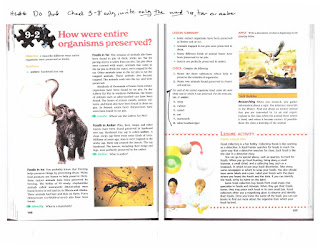
This is HL #7

This is HL #8

This is HL #9
Read the directions at the top of each page. Each should be done on a single sheet of paper, properly headed.

This sheet is FYI: For Your Information. It should be pasted in your interactive notebook, along with all the other fossil handouts. Of course, you only need one half of the sheet!
Students will be able to:
use information from videos from the internet, supplementary reading material, and classroom discussions to
-describe how fossils are formed.
-compare and contrast relative and absolute age.
-describe geologic time scale.
The do now was to answer questions from the Mastering the FCAT transparencies.
Students received their interactive notebooks.
Students also received HL 7, 8, and 9. Each is to be done on a separate loose leaf sheet of paper, in blue/black ink or pencil, headed correctly. The handouts can be found at the top of this blog. There is also a FYI reading sheet, which will be posted at a later date. Keep all papers to put into notebook after notes on fossils.
Students watched BrainPop movies on fossils, carbon dating, and the geologic time scale.
Students spent the remainder of the period reading information, finding the main idea, and writing notes. A summary of some of the notes can be found below:
Fossils
Fossils are the remains, or traces, of organisms that lived long ago.
Steps To Fossil Formation in Rocks
- organism buried by sediment soon after it dies
- soft parts of organism decay, leaving the hard parts like shells and bones.
Molds form when an organism is buried by sediments, and the sediments change into rock. Once the organisms decays, an opening (mold) is left in the rock.
Casts form when the cavity created by the mold fills with sand or mud and hardens.
Imprints form when living things or their marks (footprint) are made in soft mud, which hardens to form the imprint.
Entire organisms can be found as fossils. Entire mammoths have been trapped in ice. Animals on their way to drink, slipped into tar pits.
Small insects can be trapped in tree amber.
Scientists study fossils to determine have many living things have become extinct, how living things change over the earth, and how the earth’s climate and surface have changed over millions of years.
































